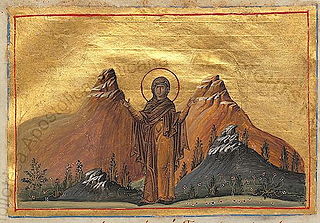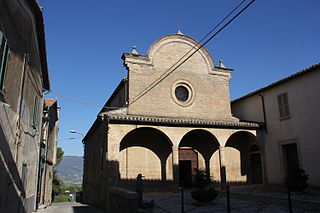
Agnes of Rome is a virgin martyr, venerated as a saint in the Catholic Church, Oriental Orthodox Church and the Eastern Orthodox Church, as well as the Anglican Communion and Lutheran Churches. She is one of several virgin martyrs commemorated by name in the Canon of the Mass, and one of many Christians martyred during the reign of the Roman emperor Diocletian.

Catherine of Alexandria, also spelled Katherine is, according to tradition, a Christian saint and virgin, who was martyred in the early fourth century at the hands of the emperor Maxentius. According to her hagiography, she was both a princess and a noted scholar who became a Christian around the age of 14, converted hundreds of people to Christianity and was martyred around the age of 18. More than 1,100 years after Catherine's martyrdom, Joan of Arc identified her as one of the saints who appeared to and counselled her.

Saint Peter's tomb is a site under St. Peter's Basilica that includes several graves and a structure said by Vatican authorities to have been built to memorialize the location of Saint Peter's grave. St. Peter's tomb is alleged near the west end of a complex of mausoleums, the Vatican Necropolis, that date between about AD 130 and AD 300. The complex was partially torn down and filled with earth to provide a foundation for the building of the first St. Peter's Basilica during the reign of Constantine I in about AD 330. Though many bones have been found at the site of the 2nd-century shrine, as the result of two campaigns of archaeological excavation, Pope Pius XII stated in December 1950 that none could be confirmed to be Saint Peter's with absolute certainty. Following the discovery of bones that had been transferred from a second tomb under the monument, on June 26, 1968, Pope Paul VI said that the relics of Saint Peter had been identified in a manner considered convincing. Only circumstantial evidence was provided to support the claim.

Montefalco is a historic small hill town in Umbria, Italy, with a population of 5,581 in August 2017. It has been settled since pre-Roman times, and retains many of its historic buildings. From 1446 to 1861 it was part of the Papal States. It is one of I Borghi più belli d'Italia.

Saint Nino was a woman who preached Christianity in the territory of the Kingdom of Iberia, in what is modern-day Georgia. Her preaching resulted in the Christianization of Iberia.

Thecla was a saint of the early Christian Church, and a reported follower of Paul the Apostle. The earliest record of her life comes from the ancient apocryphal Acts of Paul and Thecla.

Eastern Orthodoxy, otherwise known as Eastern Orthodox Christianity or Byzantine Christianity, is one of the three main branches of Chalcedonian Christianity, alongside Roman Catholicism and Protestantism. Like the Pentarchy of the first millennium, the mainstream Eastern Orthodox Church is organised into autocephalous churches independent from each other. In the 21st century, the number of mainstream autocephalous churches is seventeen; there also exist autocephalous churches unrecognized by those mainstream ones. Autocephalous churches choose their own primate. Autocephalous churches can have jurisdiction (authority) over other churches, some of which have the status of "autonomous" which means they have more autonomy than simple eparchies.

Marian hymns are Christian songs focused on Mary, mother of Jesus. They are used in both devotional and liturgical services, particularly by the Roman Catholic, Eastern Orthodox, Oriental Orthodox, Anglican, and Lutheran churches. They are often used in the month of May devotions. Some have also been adopted as Christmas hymns. Marian hymns are not popular among some Protestants, as they see Marian veneration as idolatry. However, the practice is very common among Christians of Catholic traditions, and a key component of the Eastern Orthodox liturgy. There are many more hymns to Mary within the Eastern Orthodox yearly cycle of liturgy than in Roman Catholic liturgy.

August 12 - Eastern Orthodox liturgical calendar - August 14

Romanos the Melodist was a Byzantine hymnographer and composer, who is a central early figure in the history of Byzantine music. Called "the Pindar of rhythmic poetry", he flourished during the sixth century, though the earliest manuscripts of his works are dated centuries after this. He was the foremost Kontakion composer of his time.

Antonio di Benedetto Aquilo degli Aquili, known as Antoniazzo Romano, was an Italian Early Renaissance painter, the leading figure of the Roman school during the latter part of the 15th century. He "made a speciality of repainting or interpreting older images, or generating new cult images with an archaic flavor", in particular by very often using the gold ground style, which was unusual by this period.

Euphemia, known as Euphemia the All-praised in the Eastern Orthodox Church, was a virgin martyr, who died for her faith at Chalcedon in 303 AD.
Jacopone da Todi, O.F.M. was an Italian Franciscan friar from Umbria. He wrote several laude in the local vernacular. He was an early pioneer in Italian theatre, being one of the earliest scholars who dramatised Gospel subjects.

Saint Praxedes, called "a Roman maiden", was a saint and virgin who lived in the Roman Empire during the 2nd century. Along with her sister, Saint Pudentiana, she provided for the poor and gave care and comfort to persecuted Christians and martyrs. Her veneration began in the 4th century and many churches have been dedicated to her.

Marina, distinguished as Marina the Monk and also known as Marinos, Pelagia and Mary of Alexandria, was a Christian saint from part of Asian Byzantium, generally said to be present-day Lebanon. Details of the saint's life vary.

November 28 - Eastern Orthodox liturgical calendar - November 30

Saint Demiana and the 40 Virgins was a Coptic martyr of the early fourth century.

March 15 - Eastern Orthodox liturgical calendar - March 17

Sant'Illuminata is a Renaissance-style, Roman Catholic church located at the corner of Via Santa Chiara and Via Severini just south of the historic center of Montefalco, in the Province of Perugia, region of Umbria, Italy. The church, originally founded alongside a female monastery, was dedicated to Illuminata of Todi, putatively a martyred saint from the 4th century who lived in a hermitage between Massa Martana and Todi, and gained veneration in this region of Umbria. The church is noted for its early 16th-century frescoes by Francesco Melanzio and others.
















